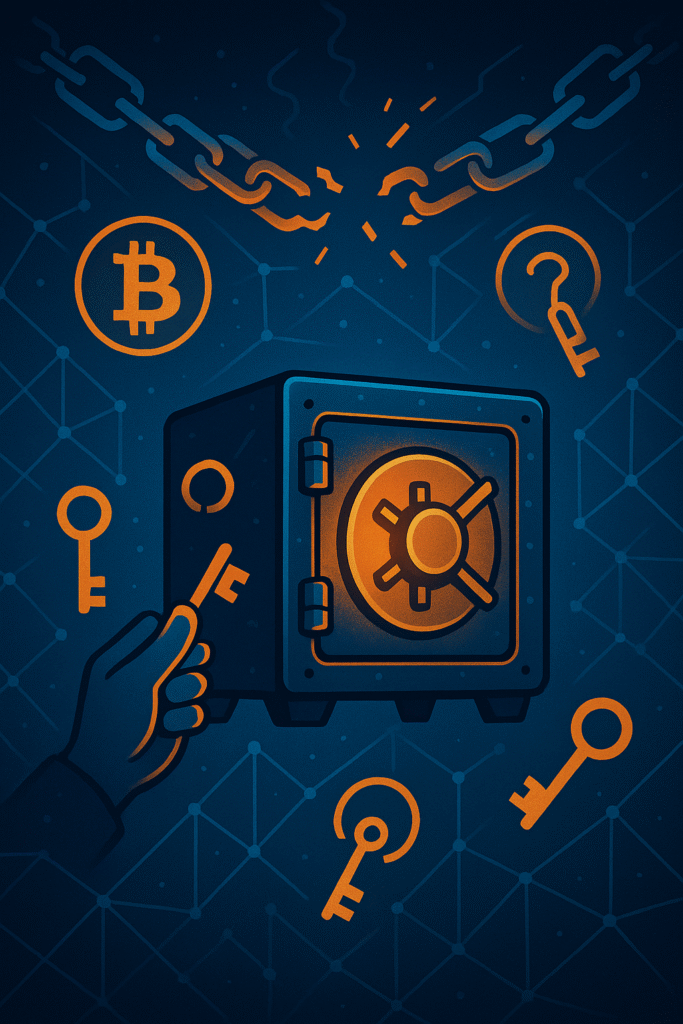Why Security and Self-Custody Are Crucial to the Bitcoin Vision

Bitcoin isn’t just a speculative asset or payment tool. It’s a radical monetary breakthrough built on decentralization, censorship resistance, and sovereign ownership. And to benefit from what Bitcoin truly offers, you must secure it yourself.
🧱 The Foundation: Decentralization and Trustlessness
Bitcoin runs without any central authority. No banks. No governments. No CEOs. Instead, the organization operates through a network of nodes and miners who enforce strict protocol rules.
Every user can validate Bitcoin transactions themselves. This transparent system ensures that no one can forge, alter, or manipulate the money supply. But to truly benefit from this model, you must hold your keys and verify yourself.
🔐 What Is Self-Custody (and Why It Matters)?
Self-custody means you control your private keys—and therefore, your Bitcoin. If someone else controls the keys, they control the coins. It’s that simple.
Exchanges might show you a balance, but unless you hold the private keys, you’re just holding an IOU.
The phrase “Not your keys, not your coins” exists for a reason.
🚫 The Danger of Third-Party Risk
Trusting exchanges and custodians reintroduces the very thing Bitcoin was meant to eliminate, counterparty risk.
Platforms can be:
- Hacked
- Shut down
- Mismanaged (FTX, Celsius, Mt. Gox)
- Forced by governments to freeze or seize funds
In these cases, users often lose everything. Bitcoin fixes this—if you use it right.
✊ Self-Custody Unlocks Bitcoin’s Real Power
Holding your own keys gives you access to Bitcoin’s most powerful features:
| Benefit | What It Means |
|---|---|
| Censorship Resistance | No one can block or reverse your transactions. |
| Seizure Resistance | Bitcoin secured with your keys can’t be confiscated without consent. |
| Portability | Move wealth anywhere with just your seed phrase. |
| Durability | Bitcoin runs on a global, anti-fragile network—not on fragile institutions. |
⚠️ Real-World Examples of What Could Happen Without Self-Custody
Real-World Failures of Trusting Third Parties
When you trust others to hold your Bitcoin, you expose yourself to **counterparty risk**. These real-world examples show how that risk plays out:
| Example | What It Means |
|---|---|
| MakerDAO custody with Coinbase | By relying on a centralized custodian, MakerDAO’s assets became vulnerable to government seizure or platform failure. |
| Centralized wallets as honeypots | When many users store funds in one place, it becomes a prime target for hackers and exploits. |
| Travel Rule enforcement | Legacy financial regulations can force exchanges to track and report users, undermining privacy and decentralization. |
| Exchange shutdowns | Regulatory crackdowns or insolvency can lock you out of your Bitcoin with no warning and no recourse. |
🛠️ Take Action: Security Is a Progression
Step-by-Step: Strengthen Your Bitcoin Security
Don’t get overwhelmed. Just take one step forward today. Here’s a security journey you can research and consider, starting simple and building confidence as you go:
| Step | What to Do | What It Means |
|---|---|---|
| 1 | Prepare to withdraw Bitcoin from exchanges | Stop relying on third parties—move your funds into your own hands. |
| 2 | Use a mobile hot wallet | A beginner-friendly way to get comfortable managing your own keys. |
| 3 | Move to a hardware wallet (cold storage) | Take your Bitcoin offline where hackers can’t touch it. |
| 4 | Add a passphrase | Boost your wallet’s security with a secret only you know. |
| 5 | Explore multisig setups | Split control across multiple keys—no single point of failure. |
.
Remember: Bitcoin’s promise isn’t about price—it’s about freedom. It’s a tool for reclaiming control, resisting censorship, and opting out of broken systems.
Self-custody is how you claim that promise.
Start today. Learn. Improve. Take control.
Because freedom doesn’t wait—and neither should you.
